Trajektorienoptimierung mit TOMATO und SOPHIA
Entlang der ehrgeizigen Ziele des Single European Sky (SESAR) zur Kapazitätssteigerung sowie Kosten- und Emissionssenkung sollen Luftraumnutzer zukünftig von einigen der zahlreichen Restriktionen in der Flugdurchführung befreit werden. So soll diesen im Rahmen der Trajectory Based Operations (TBO) und Reference Business Trajectories (RBT) selbst die Wahl einer für dessen Bedürfnisse optimales, effizientes Flugprofil überlassen werden. Die Professur entwickelt hierfür Modelle, welche optimierte und von Wegpunkten losgelöste Trajektorien in einer vierdimensionalen Umgebung bestimmen können.
Dabei handelt es sich in erster Linie um eine Identitfikation des ökoeffizientesten Flugpfades mit der gekoppelten Berechnung eines energieoptimalen Vertikalprofils durch das Flugleistungsmodell SOPHIA (Sophisticated Aircraft Performance Model). Beide Module sind mitsamt einem Bewertungsmodul in der Plattform TOMATO (TOolchain for Multicriteria Aircraft Trajectory Optimization) zur iterativen Optimierung verankert. Die Abbildung 1 stellt die Ein- und Ausgangsdaten sowie den Prozess der Optimierung dar.
TOMATO und SOPHIA werden in den folgenden Projekte genutzt und weiterentwickelt:
- ATLAS: Air Transport Analysis and Technology Synergy Study
- ReMAP: Risk analysis and conflict resolution of multi-criteria-efficient approach and departure procedures
- ProfiFuel: Improved planning and realization of flight profiles with the lowest ecological footprint and minimum fuel consumption
- UTOPIA II: Enhanced Flight Planning by introducing stochastic trajectory data
- CDO-Speedbrakes: Optimized CDO under uncertain environmental and mission conditions
- MEFUL: Minimizing Flight Emissions while Sustaining Guaranteed Operational Safety as a Contribution to an Environmental Friendly Air Transport System
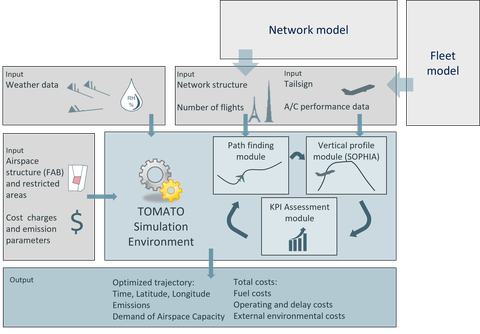
Abbildung 1: Workflow der Trajektorienoptimierung und -bewertung mittels TOMATO
Die Optimierung von Trajektorien erfolgt durch die iterative Anwendung eines Flugleistungsmodells und eines Algorithmus zur lateralen Pfadsuche innerhalb der Simulationsumgebung TOMATO. In TOMATO werden die Eingabeparameter für beide Modelle definiert und die Trajektorien auf Basis der betrachteten KPIs bewertet. In obiger Abbildung 1 ist der iterative Berechnungsprozess zwischen Pfadsuche und Flugleistungsmodellierung auf Basis vielfältiger Eingangsdaten grafisch dargestellt.
Die Eingabeparameter werden durch die gewünschten Flugverbindungen, dem jeweiligen Luftfahrzeugtyp und Triebwerkskonfiguration, Betriebskosten, Wetterdaten sowie die Luftraumstruktur definiert. Hiermit wird zuerst ein lateraler Flugpfad für eine Zielflughöhe berechnet, welcher nach der gewünschten Zielfunktion (z.B. minimale Kosten) optimal bestimmt wird. Zu diesem Zweck wird ein leistungsfähiger und effizienter A*-Algorithmus angewandt, welcher auf kostenminimalen Weg und unter Berücksichtigung eventueller Beschränkungen im Luftraum sowie Windvektoren eine Verbindung zwischen Start und Ziel und optional unter Einbeziehung von Wegpunkten herstellt. Hierfür wird eine zellenbasierte Umgebung mit variabler longitudinaler Auflösung erzeugt. Diese wird derart rotiert, dass der Startpunkt einen Pol repräsentiert und von diesem Punkt aus kürzeste Distanzen zu benachbarten Knoten gefunden werden können. Alternativ können für die Berechnungen auch Vorgaben entlang des AIRAC Cycles berücksichtigt werden. Zeitabhängige Parameter wie die dynamische Änderung des Wetters während des Fluges kann zudem in der Pfadsuche durch Abschätzung der Entfernung vom Startpunkt und einer mittleren Reisegeschwindigkeit einbezogen werden.
Die berechnete Route, Wetterdaten, das Luftfahrzeug und Metadaten zum Flug werden anschließend an das Flugleistungsmodell SOPHIA übergeben, um eine Vertikaltrajektorie für die gegebene Flughöhe und Zielfunktionen zu bestimmen. Hierdurch lassen sich durch SOPHIA Emissionen und Kraftstoffverbrauch bestimmen, welche neben anderen Faktoren zurück in TOMATO fließen und in einem Assessment Modell konsolidiert bewertet werden. In einer nächsten Iteration ändert TOMATO die Eingabeparameter (z.B. Zielflughöhe) und prüft nach wiederum erfolgter Optimierung eine Verbesserung der Trajektorie.
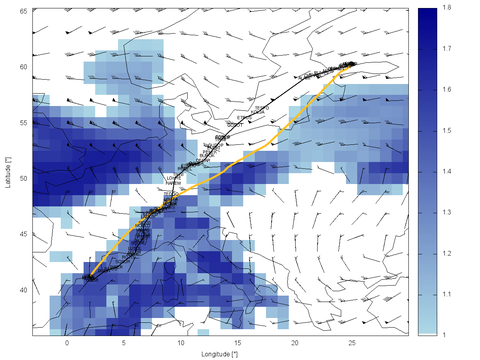
Abbildung 2: Darstellung eines Fluges von Madrid nach Helsinki am 04.08.2018, 13:00 Uhr als wegpuntlose Trajektorie (gelb) sowie unter ATS-Restriktionen basierend auf dem AIRAC-Cycle (schwarz). Blau eingefärbte Bereiche heben eisübersättigte Gebiete mit hoher Wahrscheinlichkeit zur Entstehung von Kondensstreifen hervor, welche ggf. in der multikriteriellen Optimierung gemieden werden.
Im Zuge der ambitionierten Ziele von SESAR sind zur Bestimmung optimierter und von Wegpunkten losgelöster Trajektorien präzise Flugleistungsmodelle notwendig, welche auch reale Wetterbedingungen einbeziehen. Das am Institut entwickelte Modell SOPHIA erfüllt diese Anforderungen. Um kontinuierliche Änderungen in Geschwindigkeit und Beschleunigung des Luftfahrzeuges abzubilden, werden instationäre Bewegungsgleichungen analytisch gelöst. Dynamische Variablen werden zudem durch einen Luftfahrzeug-spezifischen PID-Regler (proportional–integral–derivative controller) geregelt. Hierdurch basiert das Modell alleinig auf grundlegenden physikalischen Gleichungen (mit Ausnahme der Widerstandspolare, welche durch das Open Source Aircraft Performance Model (OpenAP, [1]) approximiert wird), was zu lösbaren Trajektorien führt. In SOPHIA sind verschiedene Luftfahrzeug- und Triebwerkstypen integriert, womit das Luftfahrzeug-spezifische Verhalten detailliert nachgebildet und Emissionen berechnet werden können. Unten stehende Abbildungen 3 und 4 zeigen für den Flug Barcelona-Helsinki jeweils für die wegpunktlose und die AIRAC-bezogene Trajektorie das Vertikalprofil. Blau dargestellte Bereiche repräsentieren eisübersättigte Gebiete, welche durch die Optimierung gemieden werden. Abbildungen 5 und 6 zeigen für das wegpunktlos optimierte Flugprofil zusätzlich Ziel- und Fluggeschwindigkeit, Schub und Kraftstoffdurchfluss.
SOPHIA bestimmt die Trajektorie durch Anwendung von Zielfunktionen und führt Rechenschritte zeitlich diskretisiert (1 s) durch. Hierdurch entfallen fixe Wegpunkte und Stützstellen bei der Modellierung, was die Optimierung weniger restriktiv macht. Im Zuge der Shared Business Trajectory (SBT) und der Reference Business trajectory (RBT) aus den Anforderungen des SES müssen die berechneten Trajektorien wieder in Wegpunkte überführt werden. Dies ist dann der Fall, wenn ein vereinfachter Austausch der Trajektorien zwischen den Stakeholdern des Luftverkehrs erfolgen sollte und ein gemeinsames Optimum bestimmt wird. Da jedoch die angewandten Zielfunktionen gerade bei der Berücksichtigung externer Einflüsse näher am Optimum liegen werden, sollten eher diese Zielfunktionen und Eingangsparameter zwischen den beteiligten Partnern auf einer Plattform geteilt und jeweils dort die Trajektorie berechnet werden.
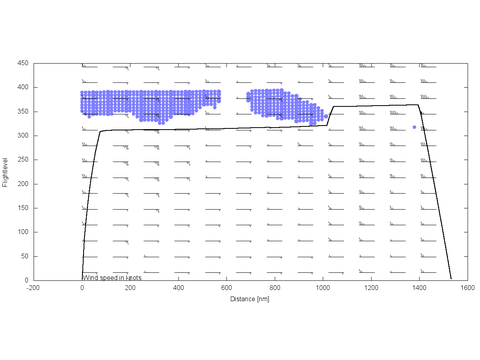
Abbildung 3: Optimiertes Vertikalprofil für die AIRAC-basierte Trajektorie, welche zudem eisübersättigte Gebiete meidet (blau). Gegen- und Rückenwindkomponenten sind als Windpfeile dargestelt.

Abbildung 4: Optimiertes Vertikalprofil für die wegpunktlose Trajektorie, welche zudem eisübersättigte Gebiete meidet (blau). Gegen- und Rückenwindkomponenten sind als Windpfeile dargestelt.
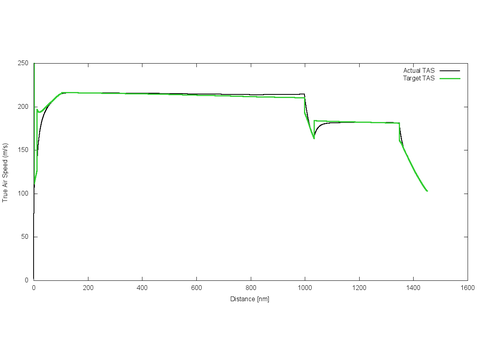
Abbildung 5: Führungs- (Target) und Regelgröße als True Air Speed (m/s) für das wegpunktlos optimierte Flugprofil.
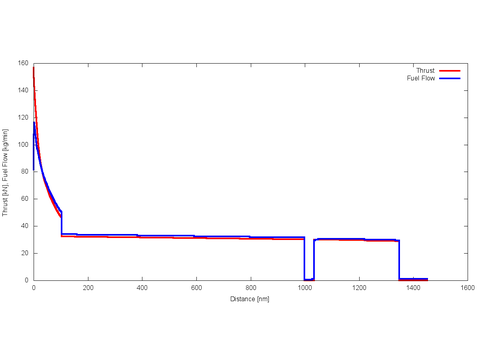
Abbildung 6: Schub (Thrust, kN) und Kraftstoffdurchfluss (Fuel Flow, kg/min) für das wegpunktlos optimierte Flugprofil.
|
[1] |
Sun, J.; Hoekstra, J.M.; Ellerbroek, J. OpenAP: An Open-Source Aircraft Performance Model for Air Transportation Studies and Simulations. Aerospace 2020, 7, 104. https://doi.org/10.3390/aerospace7080104 |
- Jan Evler, Judith Rosenow, Hartmut Fricke, (2022): Airline Schedule Recovery at Hub Airports including Dynamic Cost Indexing and Re-Routing, International Conference on Research in Air Transportation (ICRAT 2022), Tampa, FL
- Thomas Zeh, Martin Lindner, Judith Rosenow, Hartmut Fricke, (2022): Optimization of Departure Routes Beyond Aircraft Noise Abatement, International Conference on Research in Air Transportation (ICRAT 2022), Tampa, FL
Best Paper Award in Trajectory Modeling/Optimization track - Judith Rosenow, Thomas Sachwitz, Shumpei Kamo, Gong Chen and Hartmut Fricke (2022) Aircraft-Type-Specific Impact of Speed Brakes on Lift and Drag Aerospace 2022, 9 (5), 263, https://doi.org/10.3390/aerospace9050263
- Judith Rosenow, Ehsan Asadi, Daniel Lubig, Michael Schultz and Hartmut Fricke (2022), Long Range Air Traffic Flow Management with Flight-Specific Flight Performance, Stats 2022, 5 (1), 312-338;https://doi.org/10.3390/futuretransp2020017
-
Gong Chen, Hartmut Fricke, Ostap Okhrin and Judith Rosenow (2022), Importance of Weather Conditions in a Flight Corridor, Stats 2022, 5 (1), 312-338;https://doi.org/10.3390/stats5010018
-
Judith Rosenow, Gong Chen, Hartmut Fricke, and Yanjun Wang (2021), Factors Impacting Chinese and European Vertical Fight Efficiency, Aerospace 2022, 9(2), 76;https://doi.org/10.3390/aerospace9020076
-
Judith Rosenow, Gong Chen, Hartmut Fricke, Xiaoqian Sun and Yanjun Wang (2021), Impact of Chinese and European Airspace Constraints on Trajectory Optimization, Aerospace 2021 8, 338;https://doi.org/10.3390/aerospace8110338
- Judith Rosenow, Martin Lindner, Joachim Scheiderer (2021), Advanced Flight Planning and the Benefit of In-Flight AircraftTrajectory Optimization Sustainability (2021)13 (3), 1383, https://doi.org/10.3390/su13031383
- Judith Rosenow, Philipp Michling, Michael Schultz, Jörn Schönberger (2020), Evaluation of Strategies to Reduce the Cost Impacts of Flight Delays on Total Network Costs, Aerospace 7 (11), 165, DOI10.3390/aerospace7110165
- Thomas Zeh, Richard Alligier, Judith Rosenow, Hartmut Fricke (2020), Prediction of the Propagation of Trajectory Uncertainty for Climbing Aircraft, 39th Digital Avionics Systems Conference, DASC 2020
- Shumpei Kamo, Judith Rosenow, Hartmut Fricke (2020) CDO Sensitivity Analysis for Robust TrajectoryPlanning under Uncertain Weather Prediction, 39th Digital Avionics Systems Conference, DASC 2020
- Martin Lindner, Judith Rosenow, Thomas Zeh, Hartmut Fricke (2020) In-Flight Aircraft Trajectory Optimization within Corridors Defined by Ensemble Weather Forecasts, Aerospace 7 (10), 144, DOI:10.3390/aerospace7100144
- Judith Rosenow, Philipp Michling, Michael Schultz (2020) Kompensationsstrategien reaktionärer Verspätungskosten, Ingenieurspiegel 3/2020
- Martin Lindner, Judith Rosenow, Stanley Förster, Hartmut Fricke (2019): Potential of integrated flight scheduling and rotation planning considering aerodynamic-, engine-and mass-related aircraft deterioration, CEAS Aeronautical Journal, volume 10, pages755–770(2019) DOI:10.1007/s13272-018-0344-x
- Judith Rosenow, Hartmut Fricke (2019): Condensation Trails in Trajectory OptimizationThirteenth USA/Europe Air Traffic Management Research and Development Seminar (ATM2019), 2019
- Judith Rosenow, Hartmut Fricke (2019): Individual Condensation Trails in Aircraft Trajectory Optimization, Sustainability, Volume 11, Issue 21, DOI: 10.3390/su11216082
- Martin Lindner, Judith Rosenow, Hartmut Fricke (2019): Aircraft trajectory optimization with dynamic input variables, CEAS Aeronautical Journal, https://doi.org/10.1007/s13272-019-00430-0
- Judith Rosenow, David Strunck, Hartmut Fricke (2019): Trajectory Optimization in Daily Operations, CEAS Aeronautical Journal, https://doi.org/10.1007/s13272-019-00429-7
- Judith Rosenow, Hartmut Fricke (2019): Impact of multi-criteria optimized trajectories on European airline efficiency, safety and airspace demand, Journal of Air Transport Management, Volume 28, pp. 133-143 https://doi.org/10.1016/j.jairtraman.2019.01.001
- Thomas Zeh, Judith Rosenow, Hartmut Fricke (2019): Interdependent Uncertainty Handling in Trajectory Prediction, Aerospace, Volume 6, Issue 12. DOI: https://doi.org/10.3390/aerospace6020015
- Judith Rosenow, Marco Berger, Martin Lindner, Hartmut Fricke (2019) Trajektorienoptimierung in der Luft, Ingenieurspiegel 3/2019
- J Rosenow, M Schultz (2018)Coupling of turnaround and trajectory optimization based on delay cost 2018 Winter Simulation Conference (WSC), 2273-2284
- Judith Rosenow and Michael Schultz (2018) 4D Trajectory Prediction with Stochastic Input Parameters, Advanced Aircraft Efficiency in a Global Air Transport System (AEGATS’18), Toulouse, France
- Judith Rosenow, Stanley Förster, Martin Lindner. Hartmut Fricke (2018): Multicriteria-Optimized Trajectories Impacting Today’s Air Traffic Density, Efficiency, and Environmental Compatibility, Journal of Air Transportation, Volume 27, Issue 1. DOI: https://doi.org/10.2514/1.D0086
- Judith Rosenow, David Strunck, Hartmut Fricke (2018): Free Route Airspaces in Functional Air Space Blocks Sixth SESAR Innovation Days, Salzburg
- Judith Rosenow, David Strunck, Hartmut Fricke (2018): Trajectory Optimization in Daily Operations, 8th International Conference on Research in Air Transportation, Castelldefels
- Judith Rosenow, Stanley Förster, Martin Lindner, Hartmut Fricke (2018): Multicriteria-Optimized Trajectories Impacting Today’s Air Traffic Density, Efficiency, and Environmental Compatibility, AIAA Journal, DOI: https://arc.aiaa.org/doi/abs/10.2514/1.D0086
- Martin Lindner, Thomas Zeh, Hartmut Fricke (2018): Reoptimization of 4D-Flight Trajectories During Flight Considering Forecast Uncertainties, 67. DGLR Kongress, Friedrichshafen
- Judith Rosenow, David Strunck, Hartmut Fricke (2018): Trajectory Optimization in Daily Operations, 8th International Conference on Research in Air Transportation, Castelldefels
- Martin Lindner, Judith Rosenow, Hartmut Fricke (2018): Dynamically Optimized Aircraft Trajectories Affecting the Air Traffic Management, 8th International Conference on Research in Air Transportation, Castelldefels
- Judith Rosenow, Hartmut Fricke, Tanja Luchkova, Michael Schultz (2018): Minimizing contrail formation by rerouting around dynamic ice-supersaturated regions, Aeronautics and Aerospace Open Access Journal, Volume 2, Issue 3
- Judith Rosenow, Hartmut Fricke, Michael Schultz (2017): Air traffic simulation with 4D multi-criteria optimized trajectories, Winter Simulation Conference 2017, Las Vegas
- Judith Rosenow, Martin Lindner, Hartmut Fricke (2017): Impact of climate costs on airline network and trajectory optimization: a parametric study, CEAS Aeronautical Journal, Volume 8
- Judith Rosenow and Hartmut Fricke (2017): Impact of Multi-critica Optimized Trajectories on European Airline and Network Efficiency, Air Transport Research Society World Conference 2017, Antwerp
- Judith Rosenow, Stanley Förster, Martin Lindner, and Hartmut Fricke (2017): Impact of Multi-critica Optimized Trajectories on European Air Traffic Density, Efficiency and the Environment, Twelfth USA/Europe Air Traffic Management Research and Development Seminar (ATM2017), Seattle
-
Judith Rosenow, Stanley Förster, and Hartmut Fricke (2016): Continuous Climb Operations with Minimum Fuel Burn, Sesar Innovation Days, Delft
-
Stanley Förster, Judith Rosenow, Martin Lindner and Hartmut Fricke (2016): A toolchain for optimizing trajectories under real weather conditions and realistic flight performance, Greener Aviation, Brussels
-
Martin Lindner, Stanley Förster, Judith Rosenow, and Hartmut Fricke (2016): Ecological Impact Of Air Traffic Control En-Route Charging Zones From Multi-Criteria Optimized Flight Paths, Greener Aviation, Brussels
-
Judith Rosenow and Hartmut Fricke (2016): Flight Performance Modeling to optimize Trajectories, DGLR Kongress, Braunschweig
-
Judith Rosenow, Stanley Förster, Martin Lindner, and Hartmut Fricke (2016): Multi-objective trajectory optimization, International Transportation, Special Edition 1, Volume 68
-
Judith Rosenow, Martin Lindner, and Hartmut Fricke (2015): Assessment of air traffic networks considering multi-criteria targets in network and trajectory optimization, DGLR Kongress, Rostock
